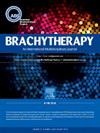Twice daily template-based interstitial brachytherapy for gynecologic cancers: What is the optimal dose?
IF 1.7
4区 医学
Q4 ONCOLOGY
引用次数: 0
Abstract
INTRODUCTION
Several factors of template-based interstitial brachytherapy in gynecologic cancers, including large tumor size, invasion into adjacent organs or fistula, dose heterogeneity, and twice daily fractionation cause inherent dose-escalation effects, potentially increasing toxicity. This study reports a single-institutional dose escalation experience in twice daily template-based interstitial brachytherapy treatments to demonstrate tumor control and toxicity outcomes, with the hypothesis that with image-based planning dose-escalation with interstitial brachytherapy is safe and efficacious.
METHODS
Patients treated with template-based interstitial brachytherapy at our institution from 2006 to 2022 were identified. Over time, HDR brachytherapy boost dose at our institution has been dose-escalated from 18.75 Gy in 5 fractions to 27.5 Gy in 5 fractions. Local control and survival outcomes were analyzed using the Kaplan–Meier method and log-rank test to compare between groups. Formal tumor control probability (TCP) analysis was performed using logistic dose-response modeling.
RESULTS
214 patients were identified with median follow-up of 28.1 months (IQR 8.2–58.7). Total HDR dose correlated significantly with local and locoregional control when analyzed as a continuous variable, and when dichotomized around median dose of 25 Gy (p = 0.024). TCP analysis showed a dose-response effect between HR CTV D90 and local control in the entire cohort, and separately in cervical and vaginal cancer subsets. The actuarial 5-year incidence of grade 3 or worse toxicity was 6.1%, and there was no significant association between toxicity and total HDR dose or HR CTV D90.
CONCLUSION
In patient treated with twice-daily template-based interstitial brachytherapy for gynecologic cancers brachytherapy dose correlates with local control with no significant association between brachytherapy dose and toxicity, thus suggesting room for dose-escalation.
每日两次基于模板的间质性近距离治疗妇科癌症:最佳剂量是多少?
基于模板的妇科肿瘤间质近距离放射治疗的几个因素,包括肿瘤体积大、侵犯邻近器官或瘘管、剂量异质性和每日两次分离,导致固有的剂量递增效应,潜在地增加毒性。本研究报告了每日两次基于模板的间质近距离放射治疗的单机构剂量递增经验,以证明肿瘤控制和毒性结果,并假设基于图像的计划剂量递增与间质近距离放射治疗是安全有效的。方法:选取2006年至2022年在我院接受基于模板的间质性近距离放射治疗的患者。随着时间的推移,我们机构的HDR近距离治疗增强剂量已经从18.75 Gy分5次增加到27.5 Gy分5次。局部对照和生存结局采用Kaplan-Meier法和log-rank检验进行组间比较。采用logistic剂量-反应模型进行正式肿瘤控制概率(TCP)分析。结果:214例患者,中位随访28.1个月(IQR 8.2 ~ 58.7)。当作为连续变量进行分析时,总HDR剂量与局部和局部区域控制显著相关,当中位剂量为25 Gy时进行二分类(p = 0.024)。TCP分析显示,在整个队列中,HR CTV D90与局部对照之间存在剂量反应效应,在宫颈癌和阴道癌亚群中也存在剂量反应效应。精算5年3级或更坏毒性发生率为6.1%,毒性与总HDR剂量或HR CTV D90之间无显著相关性。结论:在每日2次基于模板的间质性妇科肿瘤近距离放疗患者中,近距离治疗剂量与局部对照相关,近距离治疗剂量与毒性无显著相关性,提示有剂量递增的空间。
本文章由计算机程序翻译,如有差异,请以英文原文为准。
求助全文
约1分钟内获得全文
求助全文
来源期刊

Brachytherapy
医学-核医学
CiteScore
3.40
自引率
21.10%
发文量
119
审稿时长
9.1 weeks
期刊介绍:
Brachytherapy is an international and multidisciplinary journal that publishes original peer-reviewed articles and selected reviews on the techniques and clinical applications of interstitial and intracavitary radiation in the management of cancers. Laboratory and experimental research relevant to clinical practice is also included. Related disciplines include medical physics, medical oncology, and radiation oncology and radiology. Brachytherapy publishes technical advances, original articles, reviews, and point/counterpoint on controversial issues. Original articles that address any aspect of brachytherapy are invited. Letters to the Editor-in-Chief are encouraged.
 求助内容:
求助内容: 应助结果提醒方式:
应助结果提醒方式:


